Gingivitis and dental disease is one of the most common problems plaguing dogs today. In fact, according to a study by the American Veterinary Dental Society, as many as 80% of dogs have symptoms of gum and dental disease by the time they are three years old. Studies have also shown that dental problems can contribute to an array of other health problems, making it one of the most prevalent, but also most treatable medical conditions.
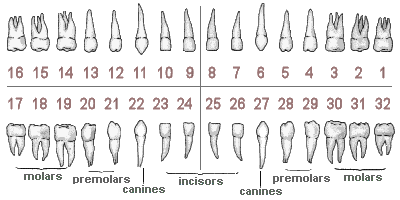 Dogs have 42 permanent, adult teeth in their mouths, and just like people, they need regular attention and maintenance to keep their mouths healthy. Because dogs are unable to brush, floss and care for their own teeth, they rely on you to help prevent and treat dental problems.
Dogs have 42 permanent, adult teeth in their mouths, and just like people, they need regular attention and maintenance to keep their mouths healthy. Because dogs are unable to brush, floss and care for their own teeth, they rely on you to help prevent and treat dental problems.
There are an array of different problems that can arise in your dogs mouth, but the most common are issues with the teeth and gums. Periodontal disease will affect almost all dogs at some time in their lives, but all periodontal disease begins when bacteria in the mouth begins to form a layer of plaque on the teeth. This plaque combines with food debris and minerals in the mouth to form tartar, a hard brownish substance which collects on the gum line of the teeth. The gum then reacts to the presence of the tarter by becoming inflamed, developing into gingivitis. If left untreated, this gingivitis will progress, leading to damage of the supporting structures of the tooth, tooth loss, abscesses (pockets of infection) and even bone infections into the surrounding structures. These bacteria in the mouth can also travel to other parts of the body through the bloodstream, causing sepsis and internal organ failure.
The earliest symptom of gingivitis and periodontal disease in dogs is bad breath, known as halitosis. As the disease progresses, so does the severity of symptoms, and affected dogs may begin to avoid chewing hard foods, have excessive drooling, or stop eating due to the pain of their dental problems. In severe cases, a runny nose and sneezing, and swelling along the face may be an indicator of severe infection in the mouth.
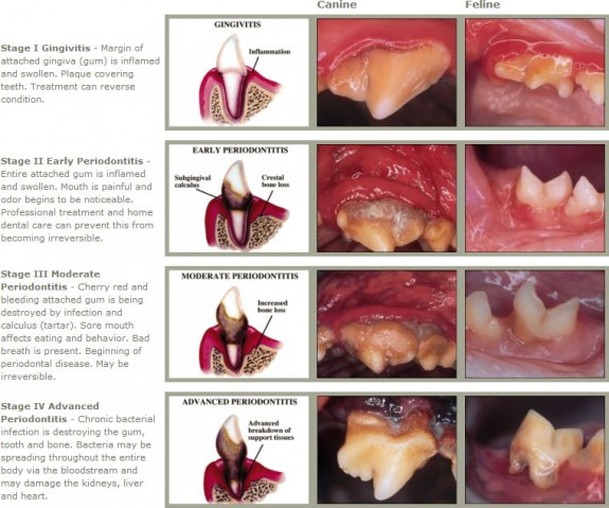 A quick glance of your dogs teeth at home may reveal the presence of obvious tartar accumulation, moveable or missing teeth, pus around the gum line or swollen gum tissue. If any of these are present in your dogs mouth than a serious health problem is brewing, and it is important to see your veterinarian quickly to develop a treatment plan.
A quick glance of your dogs teeth at home may reveal the presence of obvious tartar accumulation, moveable or missing teeth, pus around the gum line or swollen gum tissue. If any of these are present in your dogs mouth than a serious health problem is brewing, and it is important to see your veterinarian quickly to develop a treatment plan.
 The best method of treatment of dental disease and gingivitis in dogs is through prevention. Just as in people, the best way of avoiding the development of dental problems is by regular brushing performed with either a specially designed dog toothbrush or finger brush, regular brushing (3 times a week or more) will greatly reduce the amount of plaque that accumulates on the teeth, thereby curbing tartar development and stopping the formation of gingivitis. Human toothpaste should not be used in dogs as it can cause digestion upsets, but your veterinarian or local pet store can recommend an appropriate toothpaste for use. I recommend Both Oxyfresh and Tropiclean brands. Both of which are available thru this site. Although it may take a bit of patience to get your dog accustomed to having his teeth brushed, the health advantages of preventing severe periodontal disease is well worth it both physically and financially. Depending upon where you live in the country, pet dental cleaning’s can cost anywhere from $150.00 up to $300.00. It can be even more expensive and painful if your dog needs to have some teeth pulled. For tips on teeth brushing, read our teeth brushing article located under the Oral Hygiene category.
The best method of treatment of dental disease and gingivitis in dogs is through prevention. Just as in people, the best way of avoiding the development of dental problems is by regular brushing performed with either a specially designed dog toothbrush or finger brush, regular brushing (3 times a week or more) will greatly reduce the amount of plaque that accumulates on the teeth, thereby curbing tartar development and stopping the formation of gingivitis. Human toothpaste should not be used in dogs as it can cause digestion upsets, but your veterinarian or local pet store can recommend an appropriate toothpaste for use. I recommend Both Oxyfresh and Tropiclean brands. Both of which are available thru this site. Although it may take a bit of patience to get your dog accustomed to having his teeth brushed, the health advantages of preventing severe periodontal disease is well worth it both physically and financially. Depending upon where you live in the country, pet dental cleaning’s can cost anywhere from $150.00 up to $300.00. It can be even more expensive and painful if your dog needs to have some teeth pulled. For tips on teeth brushing, read our teeth brushing article located under the Oral Hygiene category.
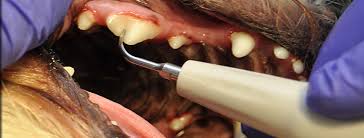 Unfortunately, often by the time dental problems are discovered, they have progressed too far to be significantly improved with teeth brushing. In these cases, a thorough teeth cleaning and scaling will need to be performed by your veterinarian. Because a proper cleaning and examination of the teeth requires the complete cooperation of the dog, general anesthesia is required to perform a dental cleaning.
Unfortunately, often by the time dental problems are discovered, they have progressed too far to be significantly improved with teeth brushing. In these cases, a thorough teeth cleaning and scaling will need to be performed by your veterinarian. Because a proper cleaning and examination of the teeth requires the complete cooperation of the dog, general anesthesia is required to perform a dental cleaning.
Prior to having a dental cleaning, your veterinarian will want to perform a complete physical exam, and may want to have blood work done on your pet to access the health of their organs and examine blood counts. Rest assured that all tests performed prior to the dental cleaning are to ensure the safest anesthetic experience possible for your dog.
 Once under anestesia, your veterinarian will perform a thorough oral examination of the mouth, teeth and gums, checking for abnormal teeth, loose or missing teeth, mouth ulcers, abscesses of the teeth, sites of infection and other problems. Depending on the severity of issues seen in the mouth, your vet may opt to take one or more dental X-rays (like the ones you get at the dentists office!) to further evaluate the teeth, and make sure that more severe problems are not lurking below the surface of the teeth. Dental X-rays can help detect teeth that are abscessed, or have severely compromised root systems, both conditions that may necessitate the extraction of the associated teeth.
Once under anestesia, your veterinarian will perform a thorough oral examination of the mouth, teeth and gums, checking for abnormal teeth, loose or missing teeth, mouth ulcers, abscesses of the teeth, sites of infection and other problems. Depending on the severity of issues seen in the mouth, your vet may opt to take one or more dental X-rays (like the ones you get at the dentists office!) to further evaluate the teeth, and make sure that more severe problems are not lurking below the surface of the teeth. Dental X-rays can help detect teeth that are abscessed, or have severely compromised root systems, both conditions that may necessitate the extraction of the associated teeth.
In general, the following steps will be taken during your dogs dental cleaning. First, an ultrasonic scaler will be used along the surface of the teeth, as well as below the gum line, to remove accumulated tartar and plaque. After scaling, the teeth are polished to restore a smooth surface, making it more difficult for future bacteria and plaque to adhere to the teeth. The mouth will be flushed with an anti-bacterial solution to help restore a healthy atmosphere, and then if needed, a fluoride treatment may be performed to strengthen the teeth.
Depending on the severity of problems in your dogs mouth, your veterinarian may prescribe a course of antibiotics after the dental cleaning to treat any residual infections.
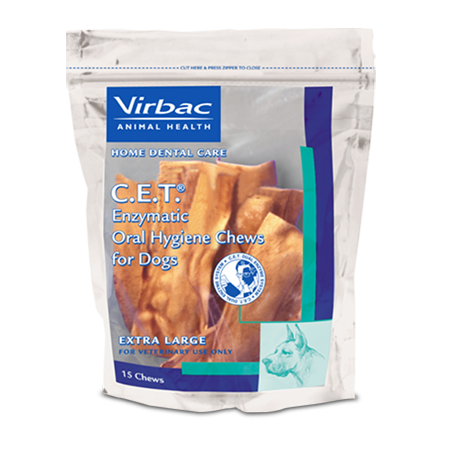
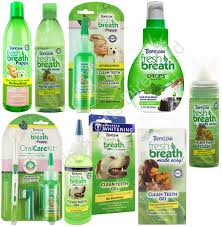 Despite home care and professional dental cleanings, some dogs are simply more prone to developing gingivitis and dental disease than others. Older dogs and small breed dogs both tend to accumulate tartar more rapidly, and require more aggressive treatment to maintain their oral and overall health .After a dental cleaning has been performed, once again prevention will play a vital role in avoiding the reoccurence of gingivitis in your dog. Most veterinarians will not tell you to brush your dog’s teeth. I sometimes question whether they actually want your dog to need his teeth cleaned on a regular basis, more revenue for them. They now sell brush less oral hygiene systems to use on your pets. These systems consist of gels or sprays that you spray or squirt on the gum area of your dog’s mouth. They also sell additives that you place in your dog’s water. In addition, there are many commercially available treats and chew toys that may help encourage healthy teeth and gums in your dog. I offer several options here on the site.
Despite home care and professional dental cleanings, some dogs are simply more prone to developing gingivitis and dental disease than others. Older dogs and small breed dogs both tend to accumulate tartar more rapidly, and require more aggressive treatment to maintain their oral and overall health .After a dental cleaning has been performed, once again prevention will play a vital role in avoiding the reoccurence of gingivitis in your dog. Most veterinarians will not tell you to brush your dog’s teeth. I sometimes question whether they actually want your dog to need his teeth cleaned on a regular basis, more revenue for them. They now sell brush less oral hygiene systems to use on your pets. These systems consist of gels or sprays that you spray or squirt on the gum area of your dog’s mouth. They also sell additives that you place in your dog’s water. In addition, there are many commercially available treats and chew toys that may help encourage healthy teeth and gums in your dog. I offer several options here on the site.
Dogs with gingivitis and periodontal disease require immediate and aggressive care, as the condition is both very painful, and carries a risk of causing severe internal illness. Bacteria from the mouth are able to travel through the bloodstream, affecting the heart, liver and kidneys and literally may take years off your dogs life.

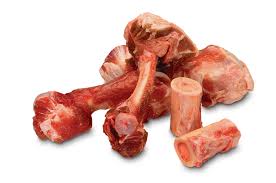 Feeding a raw diet is excellent for oral hygiene. The bones you feed in this diet clean your dogs teeth naturally. All my dogs eat a raw diet. They range in ages 7 to 15. None of them have ever needed their teeth professionally cleaned. There are dog foods on the market that claim to clean your dogs teeth. This is just another ridiculous marketing scheme on the part of dog food manufacturers. This is like saying if you and I eat corn or potato chips it will clean our teeth.
Feeding a raw diet is excellent for oral hygiene. The bones you feed in this diet clean your dogs teeth naturally. All my dogs eat a raw diet. They range in ages 7 to 15. None of them have ever needed their teeth professionally cleaned. There are dog foods on the market that claim to clean your dogs teeth. This is just another ridiculous marketing scheme on the part of dog food manufacturers. This is like saying if you and I eat corn or potato chips it will clean our teeth.
Did you ever look inside a dogs mouth and teeth after they eat dry kibble? It is stuck all over their teeth and gums and actually needs to be removed. Next time you feed your dog with one of these so called foods, check out their teeth and gums and decide for yourself!






